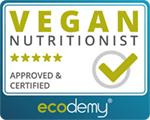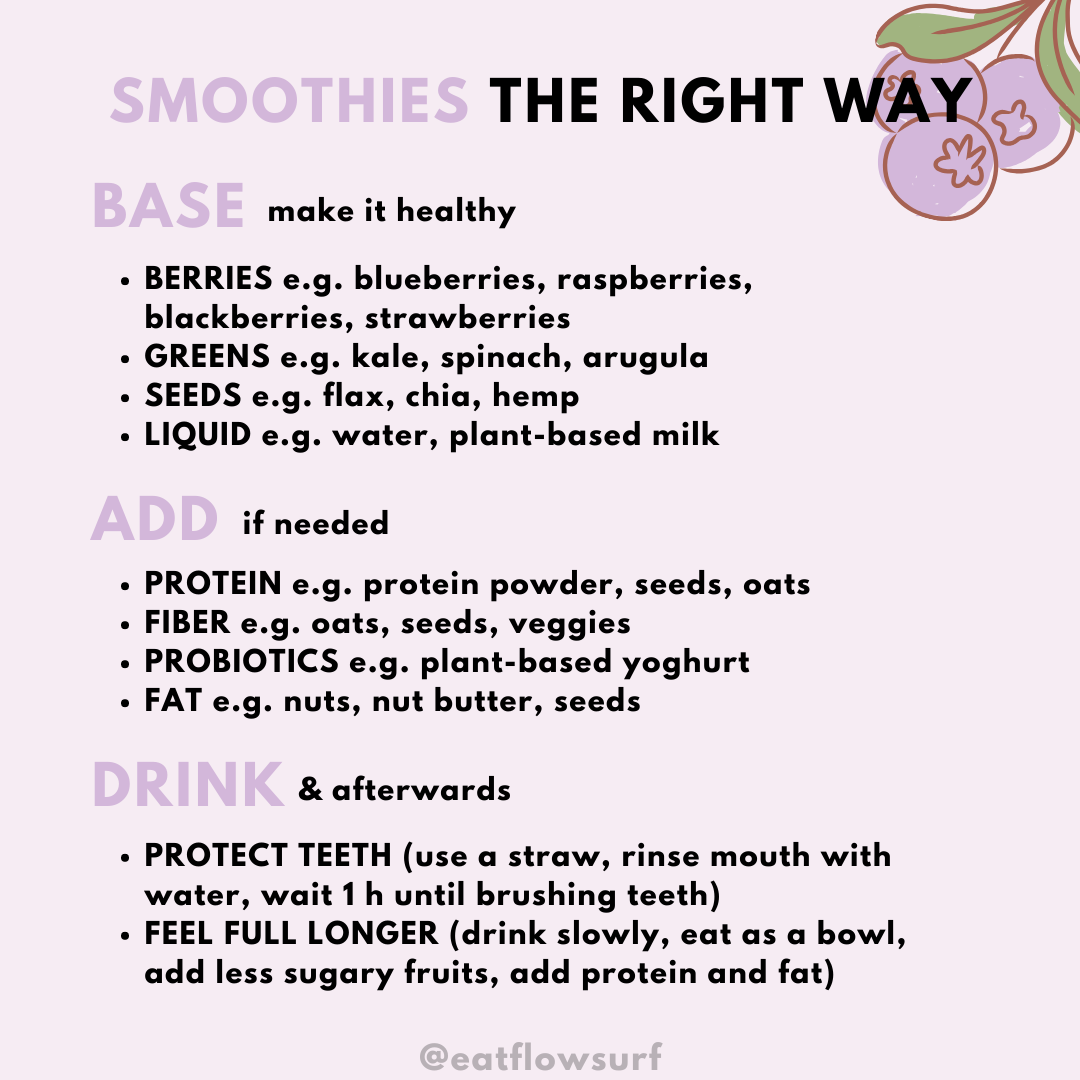Smoothies are one of the foods that every so-called ‘healthy’ person consumes every day. Let’s take a look on how healthy they really are, how to get the most out of your smoothie and some aspects to keep in mind.
Do you know what makes a smoothie healthy and how to benefit the most from them? Let’s dive in.
How to benefit from Smoothies
While a Smoothie can be a good addition to your diet, it’s important to keep in mind that they often contain a lot of (natural) sugar and energy (kcal). Popular ingredients like seeds, nut butters, sweet fruit and protein powder can add up, making your smoothie a full breakfast. Which is not always bad - I like that my morning smoothie can replace my breakfast and fill me up until lunch. But if you just want a quick snack, or addition to your regular breakfast, make a smaller amount or lower the amount of energy-rich ingredients.
I don’t say it’s ‘bad’ to put these ingredients in your smoothie. Most of the typical ingredients can be beneficial for health. Smoothies can be a great source of energy and nutrients. I just want to clarify that all these ‘healthy’ ingredients still have energy that can lead to weight gain or prevent weight loss if not consumed mindfully.
Some nutrients have a better bioavailability after blending (e.g. fat-soluble vitamins, carotenoids, folic acid).
The right combinations can be beneficial for the absorption of nutrients (e.g. Vitamin C-rich (raspberries) and Iron-rich (lamb’s lettuce) ingredients).
Examples of popular smoothie ingredients in serving size
| ingredient/serving size | kcal | protein (g) | fat (g) |
|---|---|---|---|
| 1/2 Avocado | 160 | 2 | 14.7 |
| 1 Tbl nut butter | 94 | 3.9 | 7.9 |
| 1 Tbl chia seeds | 49 | 1.7 | 3.1 |
| 1 Tbl Honey | 64 | 0.1 | 0 |
| 2 Tbl Agave Syrup | 130 | 0.0 | 0.2 |
| 30 g protein powder | 114 | 21.4 | 0 |
| 1 Tbl coconut oil | 122 | 0 | 13.5 |
exact nutrients can vary depending on type of food, producer and natural deviations
Store-bought vs. homemade
Examples of store-bought smoothies
| Food | kcal/bought size |
|---|---|
| yellow, 250 ml | 160 |
| with nuts, 250 ml | 217 |
| fortified, 360 ml | 217 |
| coconut, 250 ml | 165 |
| green, 250 ml | 125 |
exact nutrients can vary depending on type of food, producer and natural deviations
So, store-bought smoothies can be seen as a snack, but should not be the main drinking and nutrient source. They usually contain a lot less nutrients than the homemade version and more sugar.
Foods to include in your Smoothie
Good ingredients for smoothies:
- Berries are a good source for antioxidants, vitamin C, vitamin E, some iron and phytochemicals. Good for smoothies are e.g. raspberries, strawberries, blueberries and blackberries.
- Greens contain varying amounts of calcium, potassium, carotinoids, vitamin C, folic acid and phytochemicals. Good for smoothies are e.g. kale, spinach, lamb’s lettuce and arugula.
- Seeds are rich in fat (often Omega-3), protein and minerals like iron, calcium, zinc. Good for smoothies are chia and flax seeds.
- Oats are a good source for protein (11 g/100 g), fiber, potassium, iron, zinc and magnesium.
- Water as a liquid - I prefer it for smoothies: it’s cheap (tap water), adds no energy or sugar, and I’d rather add one teaspoon of nut butter for more creaminess than plant-based milk.
A little note on Omega-3’s (detailed post will follow): plant-based sources contain ALA, but not DHA and EPA, which are also very important for us. Our bodies can convert them from ALA, but only in moderation. So the Omega-3 fatty acid ALA from seeds might not be enough.
Additions for Smoothies
- Protein Powder can be a good way to increase your protein intake if needed and lead to being satisfied for a longer time. I prefer a plant-based protein with not too many ingredients and without sweeteners.
- Matcha is made from green tea leaves. It contains caffeine (less than coffee), antioxidents and has a slower caffeine release. It can also have a more calming effect than coffee while still making you feel more awake (I experience this and I like it, but I’m also a little sensitive to bigger amounts of strong coffee).
- ‘Superfoods’ like maca, acai and powedered greens.
- Nut butters like almond-, cashew- or peanut-butter, can make the smoothie more creamy and satisfying (but use in moderation).
- Bananas are a good base for most smoothies as they provide some sweetness. They are rich in Potassium and can be a good energy-source. For more creaminess or for smoothiebowls you can add a frozen banana.
- plant-based yoghurt provide the probiotic bacteria that are good for your gut
The ideal Smoothie
It’s a good idea to drink your smoothie slowly and cooled through a straw for feeling more satisfied and less hungry (a smoothie-bowl eaten with a spoon is helpful, too).
Since smoothies can have a negative impact on dental health1 (mainly because of the fruit acids), follow it up by some water to rinse your mouth and wait about 1 hour until brushing your teeth.
Find my favorite smoothie recipe right here: Berry Breakfast Smoothie
Shelf life of home-made Smoothies
With influence of light and oxygen, the vitamin amount decreases. It’s best to store in the fridge and sealed airtight for a maximum of 2 days.
My recommendation is to drink it right after blending within a few hours. Depending on the ingredients, it can thicken up a lot and be harder to drink.
Final Words
Please let me know how you like informational blog posts like this. I always appreciate some feedback ![]()
References
Script from Ecodemy (VEA Ausbildung)
Cronometer
-
Tahmassebi, J. F., P. Kandiah, and S. Sukeri. “The effects of fruit smoothies on enamel erosion.” European Archives of Paediatric Dentistry 15.3 (2014): 175-181. https://www.ncbi.nlm.nih.gov/pubmed/24072423. ↩




